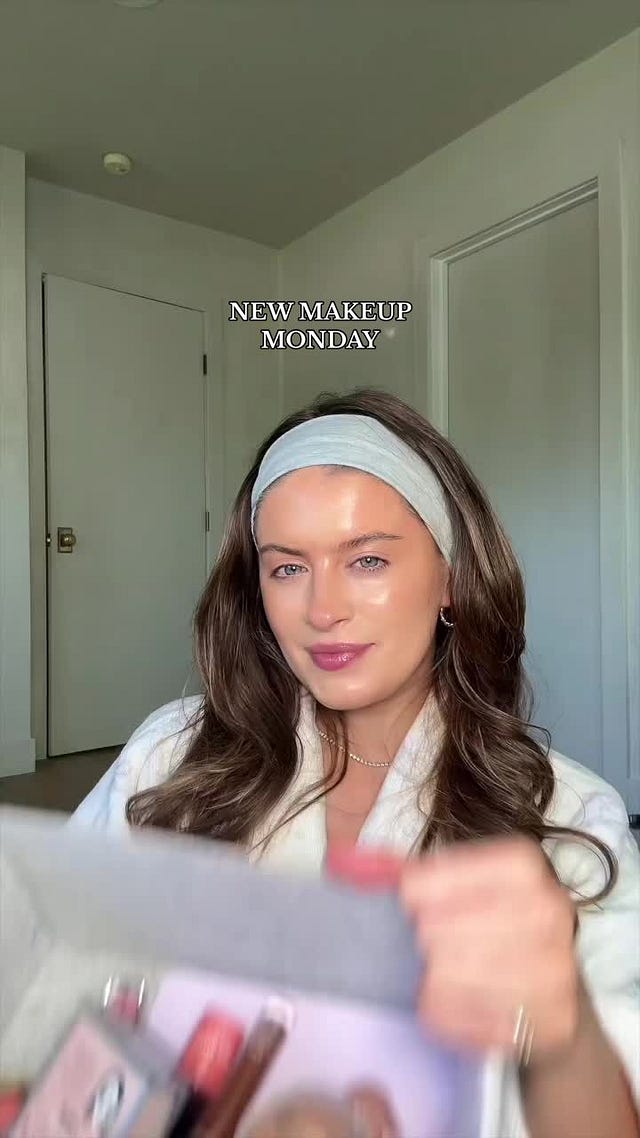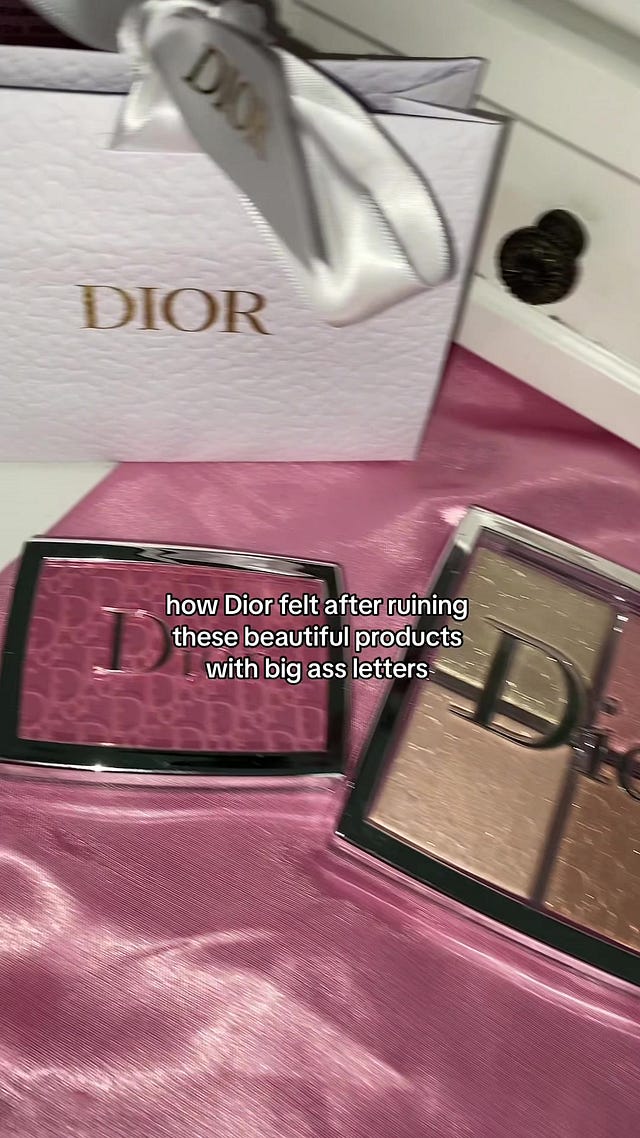Kylie. James Charles. Huda. Tati. Jefree Star. These are just a few of the influencers who changed the face of beauty.
Gen Z has come of age alongside the dawn of these cultural stars, who leveraged their looks and their communities to funnel the hard-earned attention of their audience into building iconic and global beauty brands.
The attention economy made the beauty influencer.
But it may also be the first to break it.
📈 New Research from the dcdx
The Product Review is Dying
Our Q3 2024 on Gen Z’s Top 50 Beauty Brands Report uncovered a major finding: in Q1 2023, Product Review content made up 37.8% of engagement with organic beauty content. In Q3 2024, it made up only 9.8% of the entire conversation.
There can of course be variety in what a product review looks like. Some reviews compare multiple brands, others test a single product, and some check if a cheaper "dupe" is as good as the real thing.
The TikTok below demonstrates one example of trying a range of new beauty products - a typical review format that compares and evaluates many brands at once.

 Tiktok failed to load.
Tiktok failed to load.Enable 3rd party cookies or use another browser
Reviews can also be more swift and to the point, taking aim at a single brand or product. Take the example below of a consumer criticizing the packaging aesthetics of a new Dior palette.
Compared to other themes like GRWM, Tutorials & Trends, Brand Experiences, and Lifestyle content, product reviews are more tactical, offering a pointed perspective or advice. Other content that shares trying products, like trend or tutorial content, can be more fun and lack strong opinions. Product reviews don't just instruct, they offer a POV.
Once the dominant content in the industry, the product review now comprises just a fraction of the share of attention and engagement.
That is the downside of being a dominant format in today’s rapidly evolving culture; what is “popular” can become “overused” just as quickly as it starts.
The staleness of the product review is yet another signal of a subtle but powerful shift in influence in the category.
A couple of months ago, we explored influencer fatigue and Gen Z's declining buying habits in beauty shopping. 68% of Gen Z beauty buyers are either buying less in the last year or are being more selective about their purchases.
Additionally, other studies have found signals of this shift. A Rival x Reach3 Study revealed that nearly 50% of Gen Zs are “not very likely” or “not likely at all” to buy something influencers recommend. According to data from a YPulse study shared with Yahoo News, 45% of people between the ages of 13 and 22 say influencers just don’t have the same power that they used to have.
Urban Decay Case Study
To prove this point further - let’s look at a brand that seems to be making a comeback: Urban Decay.
In Q1 of 2023, 49% of Urban Decay’s user-generated content was product reviews. In Q3 2024, only 14% of Urban Decay’s user-generated content was product reviews. With this shift in content themes have also come a rise in the ranking, going from Functional to Magnetic, and increasing its GenZ Score from #35 to #24 in the Top 50 ranking this quarter.
On top of a decline in the percent share of product review content, the brand’s relaunch of Naked OG has caused some buzz in the last quarter, and GRWM took the largest share of the conversation for the brand’s UGC.
Magnetic Brands require two elements to achieve this premium tier - popularity and consistency. Whereas popularity may come with viral moments, consistency points to the regularity of conversation. Virality without regularity is a flash in the pan; a short-term win, with little long-term consequences. Helpful, yes, but potentially harmful too.
Content that highlights the day-to-day role of the brand in the lives of Gen Z makeup consumers helped fuel more popular content for the brand. That is a signal of a brand doing something right; one that listened to more than just what is trendy (popular), but what consumers truly wanted. This is how brands become more Magnetic: a balance of reacting to what is relevant with finding the core truths that resonate. An act that starts with understanding, and with listening.
🧠 What we’re thinking
Influencers are not going anywhere anytime soon. But the way they work is already changing.
Influencers have always created brand affinity as a proxy: love for the influencer transfers to love for the brand. That model of influence is fading.
In a culture of oversaturated opinions, curators, and tastemakers, it becomes exhausting to determine what is genuine, and what is an attempt at persuasion.
This is why product reviews have lost their stopping power. Why young consumers are becoming more selective with their beauty purchasing habits. And why influencer fatigue and de-influencing have surged in the last year.
Young consumers are growing up and waking up, privy to the power of their own opinions and beliefs. Fandoms are intensifying, and loyalties solidifying.
For every action - the oversaturation of reviews, influencer content, and attempted persuasion - there is an equal and opposite reaction - de-influencing, influencer fatigue, selectivity, and fortified beliefs.
This is the push and pull of today’s culture. A forever changing, forever evolving dynamic balance.
And as the rate of cultural change continues to increase, so too will the rate of this push and pull along with it.
🔮 Where we go from here
Influence in beauty may no longer lie in creating content that presupposes any authority. The influencer of the future does not say - ‘this is the best product for you or me.’ The influencer of the future says ‘here is the hard truth you need to know to make the right decision.’ Instead of telling their audience what to buy or how to live, they equip them with knowledge and resources. They share personal experiences, honest reviews, and helpful tips that empower their followers to make informed decisions.
The influencer of the future empowers, not dictates.
They provide tools, not opinions.
They are the guides, not gatekeepers.
These are the new laws of influence - and brands need to adapt and change, or risk falling behind and into the deep, dark abyss of the Great Brand Soup.
Further Reading
You can access the full Q3 Gen Z Beauty Industry Report here. The complete version of the report is a deep dive into:
The complete report includes:
Beauty industry overview, Q3 analysis, and industry comparison insights
Brand Magnetism® Matrix of the 50 beauty brands
Matrix Overlay: Category Breakdowns, Follower Count Breakdowns
GenZ Score® Ranking of the Top 50 beauty brands
Beauty Industry Relevance Factors: Overview, Top 50 Overall Conversation Share, Top 50 Conversation Share vs 2023 Comparison, Top 10 Conversation Share Breakdown
Top 3 Brand Profiles
Overview of profiles for brands #4-#50.
Gen Z's Most Improved Beauty Brands and Gen Z's Least Improved Beauty Brands
Gen Z's Top Moments in Beauty 2024
Conclusion and Forecasting




